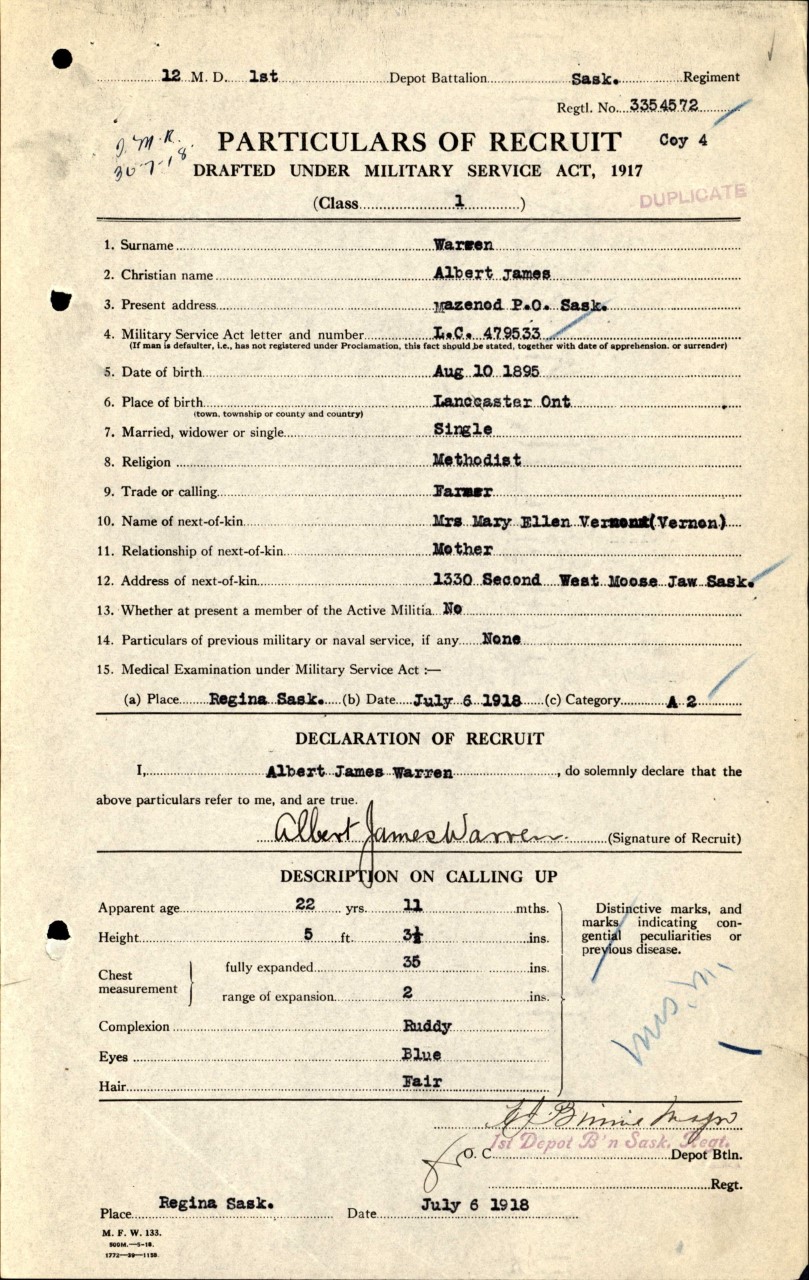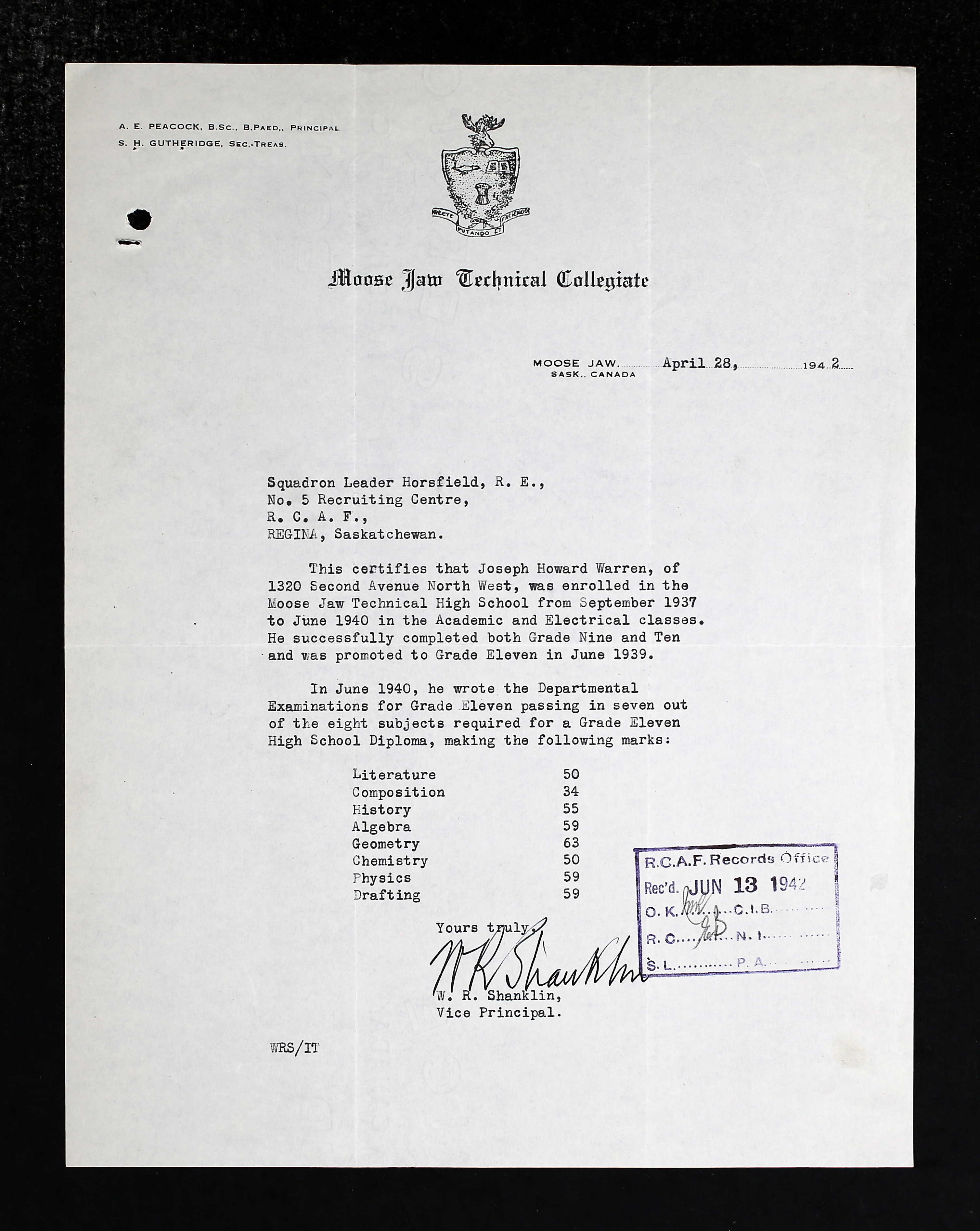



August 1, 1922 - April 22, 1943




Joseph Howard Warren, born in Moose Jaw, was the son of Albert James Warren, farmer and a veteran of WWI, and Gertrude Helen (nee Tapper) Warren. The had two sisters: Verna Helen and Evelyn Mary. Mr. Warren died in 1938. Evelyn was training to be a nurse in Vancouver by 1944. The family attended the United Church.
Joseph was a draughtsman, working for the city of Moose Jaw , Engineers Department, from 1940 to 1942 until his enlistment at No. 5 Recruiting Centre, Regina in April of 1942. He had a partial Grade XI education (seven of eight subjects) with three years of technical school from 1937 to 1940 studying draughting and electricity. His father was deceased (accident) by this time and his mother had moved to Vancouver.
Joseph enjoyed photography. He stood 5’6” tall and weighed 112 pounds. He wore glasses from 1932 to 1935. He had been a passenger for 30 minutes in an aircraft. Joseph smoked ten cigarettes a day and indicated he did not consume alcohol. He had an athletic physique and a ‘standard’ mentality.
On his interview report: “Apparently fit for trade. All Grade XI but Composition. Very young. Doubtful. Neat clean, drives car. Plays basketball and baseball. Photography for a hobby. Familiar with .22 rifle. Appearance rather immature but seems to have good civilian experience. Observer-Pilot.”
By May 13, 1942, Joseph was in Edmonton at No. 3 Manning Depot until September 12. He was then sent to No. 4 ITS, Edmonton. “Fit, doubtful pilot material. Low average observer material. Very immature at 20. Fair, sedentary build (-12 pounds). Average intelligence and co-ordination. Poor athlete, extensive church club work.”
From December 5, 1942 until February 6, 1942, Joseph was at No. 7 B&G School, Paulson, Manitoba. “Average bomb aimer. Young and should improve greatly. Theory average. Gunnery: good gunner. Very keen and willing. Understands his guns and sighting.” Joseph was 24th out of 29 in his class with a 72.4%. “Young, keen airman of average ability. Should show great improvement with experience.”
From February 7, 1943 to April 3, 1943, he was at No. 7 AOS, Portage la Prairie, Manitoba. “Navigation: Inconsistent at time but improved towards the end of the course. Slow and lacks organization. GROUND: Has fair knowledge of ground work but does not concentrate. Average bomb aimer.” He was 18th out of 24 in his class with a 74.8%.
On March 19, 1943, Joseph was awarded his Air Bomber’s Badge as well as his commission.
Joseph kept two War Savings Certificates with his mother, losing three others in Edmonton. He took out $1,590 in life insurance, his mother sole beneficiary. He also provided $30/month to his mother for support because she had only a small income. She had been a widow since the late 1930s.
Joseph traveled across the country to Halifax and was taken on strength at the Y Depot April 4, 1943. By April 14th, he was attached to the RAF Trainees’ Pool, awaiting transportation overseas.
On April 22, 1943, Joseph was aboard the Amerika, British Motor merchant ship. It was on its way from Halifax, Nova Scotia to Liverpool. It was torpedoed as the ship was heading to Britain. It was a straggler in convoy HX-234. Thirty-seven men, all officers in the RCAF, were presumed missing as a result of enemy action at sea; sixteen were landed at a British port after their ship was sunk by U-306, south of Cape Farewell, off Greenland. Forty-two crew members and seven gunners were also amongst those who were lost. The master, Christian Nielsen, 29 crewmembers, eight gunners, and sixteen passengers were picked up by the HMS Asphodel, and landed at Greenock. General cargo, including metal, flour, meat and 200 bags of mail were also lost.
On May 25, 1943, Mrs. Warren received her son’s Commission Script.
In late June 1943, a letter arrived addressed to Mrs. Warren from F/L Gunn, RCAF Casualties Officer, for Chief of the Air Staff: "Since my letter of May 6th, no additional news has been received. Attached is a list of the names and next-of-kin of sixteen Royal Canadian Air Force officers who embarked on the same ship as your son and following enemy action at sea were safely landed in the United Kingdom. The following official statement was made in the House of Commons....’I have been in receipt of communications from a number of members of this house and from people outside with reference to rumours regarding the recent loss of a number of members of the RCAF by the sinking of a ship in the north Atlantic and I desire to make the following statement on the facts. The vessel in question was a ship of British registry of 8,862 tons, designed for peace-time carriage of both passengers and freight, and having a speed of fifteen knots. She carried a crew of 86 and the passenger accommodation consisted of 12 two-berth rooms with bath and 29 other berths, providing cabin accommodations for 53 passengers. She was fitted with lifeboat capacity for 231 and travelled in naval convoy. Under the recently revised regulations agreed to by the United States authorities, the joint United Kingdom and United States shipping board, the Admiralty, the Air Ministry and the Canadian authorities, a vessel of this description travelling in convoy is permitted to embark as crew and passengers a maximum of 75% of the lifeboat capacity. The lifeboat capacity as stated above was 231, 75% of which is 173. Personnel on board consisted of the crew of 86, and RCAF personnel numbering 53, a total of 139, well within the prescribed limits. Because of the superior type of available passenger accommodation, the speed of the ship and the provision of naval convoy, the offer of the entire available space to the RCAF was immediately accepted. Rumours to the effect that this was a slow freighter not suitable for passenger accommodation are, of course, not in accord with the facts. Every precaution was taken to safeguard the lives of these gallant young men. It should be pointed out that on account of the serious shipping shortage every available berth on such ships must be used, and had the space not been taken up by the RCAF officers of the other arms of the services would have been placed on Board. It should also be stated again that the submarine is still the enemy’s most powerful weapon and that the Battle of the Atlantic is not yet won. Any ocean trip today in any part of the world is fraught with danger and I think I safely say that our record in transporting our soldiers and airmen to the United Kingdom is one of while we may all be proud. No one deplores more than I do the loss of 37 of the finest of our young men who gave their lives for their country as surely as if they had done so in actual combat with the enemy, and I extend my deepest sympathy to their loved ones in their bereavement.’ If further information becomes available, you are to be reassured it will be communicated to you at once. May I again extend to you my sincere sympathy in this time of great anxiety."
In January 1944, Mrs. Warren received a letter from Air Marshall Robert Leckie informing her that Joseph was now officially presumed to have died on Active Service on April 22, 1943.
By October 1955, Mrs. Warren was living in Moose Jaw again and she received a letter from W/C Gunn stating since that Joseph had no known grave, Joseph’s name would appear on the Ottawa Memorial.